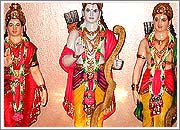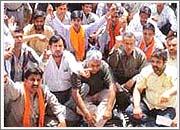"Raama Raama Raameti Rame Raame Manorame.
Sahasranaama Tattulyam Raamanaama Varaanane."
The festival of Ram Navami is the celebration of birthday of the Hindu
God, Shri Ram. Shri Ram was the seventh incarnation (Avatar) of Lord
Vishnu and born in Ayodha, an ancient Indian city. Rama Navami is
celebrated on the ninth day of Hindu month of Chaitra (April). Ram
Navami marks the end of nine day long festival called Chaitra Navratri
or Vasanta Navratri. On this auspicious day devotees observes fasting,
visits temples to offer special prayers, takes religious processions
and the special readings of Ramayana are also hold.
Lord Rama is revered by Hindus all over as the embodiment of truth, of
morality, the ideal son, the ideal husband and above all, the ideal
king. On the day of Rama Navami the birth of Rama is remembered for
his prosperous and righteous reign.
His Divine Life
Rama, the perfect avatar of the Supreme Protector Vishnu, is an
all-time favorite among Hindu deities. The most popular symbol of
chivalry and virtue, Rama the embodiment of truth, of morality, the
ideal son, the ideal husband and above all, the ideal king. The heroic
deeds of Rama and his exciting adventures have inspired generations of
people.
 Importance
Of Fasting On Ram Navami
Importance
Of Fasting On Ram Navami
A Ram devotee keep a strict fast on Ram Navami, because the Ram Navami
vrata is considered to be one of the five most important vratas in the
ancient times. According to the ancient religious texts, it is
imperative for every devotee to observe the Ram Navami vrat, as it is
the only easy mean of gaining happiness in the material world and
achieving salvation at the same time.
Celebrations
It is said that Rama fulfills the wishes of all those who pray to him
on this day. On this day, temples are decorated and the image of Lord
Ram is richly adorned. The holy Ramayana is read in the temples. At
Ayodhya, the birthplace of Sri Rama, a big fair is held on this day.
In South India the Sri Ramnavami Utsavam is celebrated for nine days
with great fervour and devotion. Traditional worship begins with
chanting Vedic mantras dedicated to Vishnu, and offering flowers and
fruit to the god. Satsangs and public gatherings are organized to
commemorate the birth of Lord Ram. Excerpts from the "Ramacharitamanas",
praising Lord Ram, are recited. Lord Ram's devotees, fast for nine
days with fruit and milk, whilst some fast on the ninth day only.
(birthday of Lord
Sri Rama)
In 2008, Hindu festival Sri Rama
Navami falls on April 14th, Monday
Sri Rama Navami is a Hindu festval that falls on the ninth day
of the Hindu lunar year (or Chaitra Masa Suklapaksha Navami)
and is a celebration of the birthday of the Hindu god Sri Rama.
People normally perform Kalyanotsavam (marriage celebration) for small
murtis of Rama and Sita in their houses, and at the end of the day the
deity is taken to a procession on the streets. This day also marks the
end of the nine-day utsavam called Chaitra Navaratri (Maharashtra) or
Vasanthothsavam (Andhra Pradesh) (festival of Spring), which starts
with Gudi Padwa (Maharashtra) or Ugadi (South India). According to
astrologers by placing the stars and the epics together it has been
said that Sri Ram was born on Feb 10, 5010 BCE.
Major Celebrations on Sri Rama Navami
-
Kalyanam (Ceremonial wedding
performed by temple priests) at Bhadrachalam on the banks of the
river Godavari in Khammam district.
-
Panakam, a sweet drink prepared on
this day with jaggery and pepper.
-
Procession of idols in the evening
that is accompanied with play of water and colours.
For the occasion, Hindus are supposed
to fast (or restrict themselves to a specific diet). Temples are
decorated and readings of the Ramayana take place. Along with Shri
Ram, people also pray to Sita (Ram's wife), Lakshman (his brother who
went on exile with him) and Hanuman (monkey god, ardent devotee of Ram
and Ram's chief of army).
On the face of it Sri-Ramnavmi appears to be just a festival
commemorating the reign of a king who was later deified. But even
behind present-day traditions there are clues which unmistakably point
to the origin of Ramnavmi as lying beyond the Ramayana story. Sri
Ramnavami occurs at the beginning of summer when the sun has started
moving nearer to the northern hemisphere. The Sun is considered to be
the progenitor of Rama's dynasty which is called the Sun dynasty (Raghukula
or Raghuvamsa, Raghu means Sun and Kula or Vamsa mean familial
descendant). Rama is also known as Raghunatha, Raghupati, Raghavendra
etc. That all these names begin with the prefix Raghu is also
suggestive of some link with Sun-worship. The hour chosen for the
observance of the lord's birth is that when the sun is overhead and is
at its maximum brilliance. In some Hindu sects, prayers on Ramnavami
day start not with an invocation to Rama but to Surya (sun). Again the
syllable Ra is used in the word to describe the sun and brilliance in
many languages. In Sanskrit, Ravi and Ravindra mean Sun.
Significantly, the ancient Egyptians termed the sun as Amon Ra or
simply as "Ra". In Latin the syllable Ra is used to connote light. For
example, we have Radiance which emission of light, or Radium which
means any substance emitting light or brilliance. The common element
is the syllable Ra which in many languages is used to derive words for
describing Sun or light.
The occurrence of this syllable in most names used for Rama along with
other clues is strongly suggestive that the festival Ramnavami
antedates the R- ayana and it must have originated much before the
Ramayana, as a 'Sun-festival' for invoking the Sun who was recognised
as the source of light and heat even in ancient times. The importance
of the Sun was much more in the higher latitudes from where the Aryans
are supposed to have migrated into India. Many royal dynasties
potrayed symbols of virility like the Sun, Eagle, Lion etc. as their
progenitor. Rama's dynasty considered themselves to have descended
from the Sun. This could have led to the tagging on, of Rama's
birthday to a festival devoted to the sun.
There is some link between Lord Rama and Sun Worship. The Sun is
considered to be the progenitor of Rama's dynasty which is called the
Sun dynasty (Raghukula or Raghuvamsa, Raghu means Sun and Kula or
Vamsa mean familial descendant). Rama is also known as Raghunatha,
Raghupati, Raghavendra etc. That all these names begin with the prefix
Raghu is also suggestive of some link with Sun-worship. The hour
chosen for the observance of the lord's birth is that when the sun is
overhead and is at its maximum brilliance. Significantly, the ancient
Egyptians termed the sun as Amon Ra or simply as "Ra". In Latin the
syllable Ra is used to connote light. For example, we have Radiance
which emission of light, or Radium which means any substance emitting
light or brilliance. The common element is the syllable Ra which in
many languages is used to derive words for describing Sun or light.


 Importance
Of Fasting On Ram Navami
Importance
Of Fasting On Ram Navami